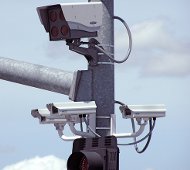3/3/2009
Opinion: Stimulating Big Brother in a FlashAn opinion piece by Richard Diamond on the use of federal money for photo enforcement.

Much of the discontent with the recently adopted economic stimulus bill has focused on the package's enormous cost. While the most expensive projects attract the most attention, taxpayers also will be affected by the small-dollar items of the sort found on the U.S. Conference of Mayors' wish list.
Take Alexandria, Virginia, for example. Officials there put in a $32,000 request for federal money to equip ten motorcycles with new moving radar units that will allow traffic police to set up mobile speed traps. According to the city's request, this project will create one "shovel-ready" new job.
It's not clear what kind of job that might be. It seems unlikely that hundreds of visitors and tourists will be eager to return to the area and support local business after running into the ticketing team. Instead, the scheme will transfer wealth from the pockets of productive citizens into the hands of municipal bureaucracy.
In these tough times, that's just what cities want. Increasing revenue in the guise of safety -- or even now in the name of homeland security -- is the order of the day. Lorain, Ohio, for example, wants $250,000 to equip ten police cars with license-plate recognition cameras. The more ambitious plan of Oakland, California, is to take $1.5 million in federal cash to ring the city with this technology, which records and identifies every passing vehicle.
In theory, these systems allow police to locate stolen cars and rescue abducted children. In reality, cities use plate-recognition systems to scan for vehicles that can be impounded because their owners failed to pay a few parking tickets or have some late library books. Add towing and storage fees to the original ticket and penalties that must be paid for the car's return and each "hit" from a license-plate recognition system can bring in a tidy sum.
Nobody better understands the lucrative new aspect of "homeland security" than our new Homeland Security Secretary, Janet Napolitano. As governor of Arizona, Miss Napolitano signed a contract with an Australian company, Redflex Traffic Systems, to blanket the state's freeways with up to 200 speed cameras.
The ambitious plan was slipped into a state budget bill last June as a means of generating $150 million in new revenue to help close the $1 billion budget gap with "non-tax increase revenue generation."
This inspired Maryland's Democratic Gov. Martin O'Malley, who is about to deploy the same fully automated speed traps on the Capital Beltway and other freeways throughout the state.
Instead of protecting the homeland, however, Mr. O'Malley's cameras will protect his bureaucracy's revenue stream. Each privately operated photo-radar van is expected to issue tickets at a rate of one-per-minute. On a typical deployment schedule, that's 96,000 tickets a year. Any time state officials need another $3.8 million in revenue, they just need to pick up the phone to order another van.
Maryland will need a worker just to count all the money it rakes in. Perhaps that will be the job created by the stimulus package.
There is one other example that stands out. Glendale Heights, Illinois, is asking Congress for $67,000 in stimulus money to hire someone to look at the pictures generated by its red-light camera system. Those cameras will be purchased with another $96,000 in stimulus money.
If the District of Columbia's experience is any evidence, Glendale Heights won't be disappointed. Over the course of a decade, red-light and speed cameras in the nation's capital have generated more than a quarter-billion dollars' worth of tickets. While this sounds like a lot, it still falls short when compared to the sums generated in Europe -- which sets the revenue standard that bureaucrats across America want to emulate.
With more than 6,000 speed cameras deployed, England issues 2 million tickets each year. France generated $600 million in revenue from photo tickets last year alone. Total revenue from all types of fines in Italy topped a staggering $2 billion in 2007.
How did Italy's total rise so high? Most observers credit the "T-Red" system of red-light cameras. Municipalities willing to shave a few seconds off the yellow warning time at intersections were instantly rewarded with a quadrupling of fine revenue as drivers found themselves trapped, photographed and billed. The camera contractors responsible for the programs ensured, behind closed doors, that key city officials shared personally in the financial success.
The party didn't last long. On January 27, an ambitious prosecutor grew fed up with the corruption. He ordered the arrest of photo-ticketing executives implicated in the plot. Another 100 local officials are under investigation.
Most shocking of all, many of the practices under scrutiny in Italy now -- especially with respect to signal timing -- are actually common in the United States. The difference is that while Italy is putting its ravenous local officials in jail, we are rewarding ours with federal bailout dollars.
This article first appeared in The Washington Times on February 27. Reprinted with permission.


